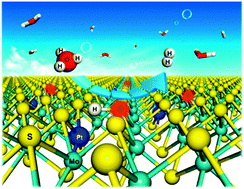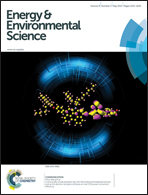Triggering the electrocatalytic hydrogen evolution activity of the inert two-dimensional MoS2 surface via single-atom metal doping†
Abstract
Electrocatalytic splitting of water is one of the most efficient technologies for hydrogen production, and two-dimensional (2D) MoS2 has been considered as a potential alternative to Pt-based catalysts in the hydrogen evolution reaction (HER). However, the catalytic activity of 2D MoS2 is always contributed from its edge sites, leaving a large number of in-plane domains useless. Herein, we for the first time demonstrated that the catalytic activity of in-plane S atoms of MoS2 can be triggered via single-atom metal doping in HER. In experiments, single Pt atom-doped, few-layer MoS2 nanosheets (Pt–MoS2) showed a significantly enhanced HER activity compared with pure MoS2, originating from the tuned adsorption behavior of H atoms on the in-plane S sites neighboring the doped Pt atoms, according to the density functional theory (DFT) calculations. Furthermore, the HER activity of MoS2 doped with a number of transition metals was screened by virtue of DFT calculations, resulting in a volcano curve along the adsorption free energy of H atoms  , which was further confirmed in experiment by using non-precious metals such as Co and Ni atoms doping 2D MoS2 as the catalysts.
, which was further confirmed in experiment by using non-precious metals such as Co and Ni atoms doping 2D MoS2 as the catalysts.


 Please wait while we load your content...
Please wait while we load your content...